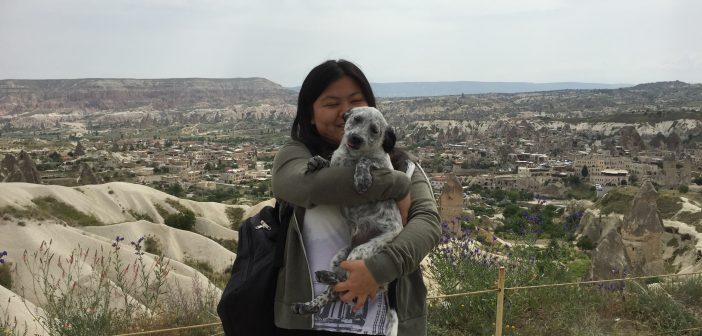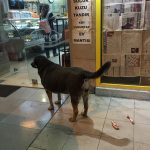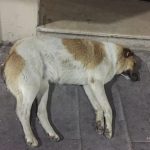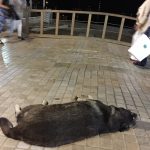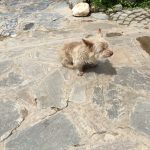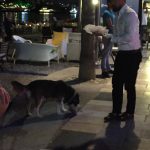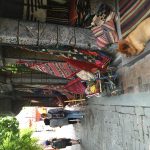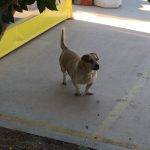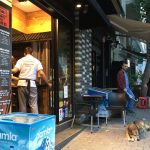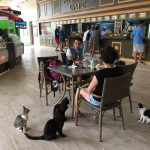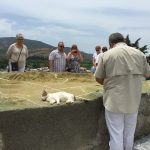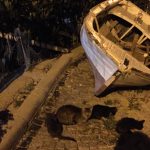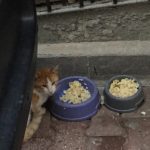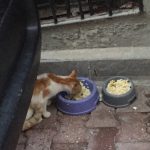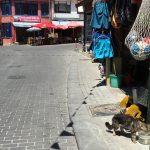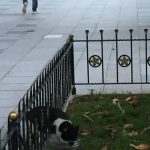(Featured image: In Urgup, me with the most cheerful, gorgeous, fun loving puppy ever, despite having just gotten kicked by the tea shop owner for being too close to his property. I just had to pick her up.)
I recently visited Turkey, from mid May to June 2016, after hearing what the Turkish have done with their large stray population. My route was around the western region, the first stop being Izmir, the second biggest city in Turkey, followed by Pamukkale, Sirince, Selcuk, Efesus, Bodrum, Antalya, Urgup, Goreme, Mustafapasha, Avanos, the capital city of Ankara, and lastly Istanbul, the largest city.
I had already heard of how strays are sterilised by the government before my trip. I saw for myself how dogs in big cities like Izmir, Ankara and Istanbul looked healthy. My route in those cities followed the major tourist spots, and there, I did not see puppies. The stray dogs I sighted always had ear tags, the sign of a fixed dog. The dogs were huge, and the crowds didn’t seem to mind their presence as they made their way around.
Please note that what I saw is what appears on the surface. There have been many great efforts for animal welfare in Turkey, but there are also suspicions of misconduct behind the scenes, and that would be another story. If you are interested, here are some links giving more detailed information:
“Turkish animal welfare bill – is it working?”
“Turkey’s solution for stray dogs is to send them far away, where they can’t survive”
The dogs were not afraid with people, a good sign that the strays suffered relatively few cruelty incidents. However, there were sad individuals. People did not hurt them, but were often indifferent, and would shoo the dogs if they got too close. The dogs wanted to get to know people, but people didn’t want to know them. The dogs felt lonely and unloved. It was easy to tell, since making eye contact was enough for the dogs to know I did want to get to know them. Calling was unnecessary. With eye contact alone, they came to me.
They were friendly, and huge. Nevertheless, they acted like puppies. They love it when you give them strokes. Talk to them, and they will eventually lay on their back enjoying your presence. It is hard to say good bye to them knowing you have no idea what will happen to them in the future.
I saw restaurant staff come from their building and give the dogs scraps, and I also saw a really well fed dog outside a meat store. For those individuals, I felt peace.
- A healthy dog just after eating raw ribs, Izmir
- A sleeping dog with an ear tag, Izmir
- Overfed dog lays in the middle of the walkway, Bodrum
- A dog sleeps in front of the tourist information office
- Handsome black-masked stray, Bodrum
- Tiny, sad looking stray terrier
- It was glorious to view restaurant staff feeding scraps to strays in Bodrum
- A pack of dogs running free on a clean and quiet street near IKEA, Izmir
The stray dogs in other, smaller cities were not as healthy as those in big cities like Izmir, Ankara, or Instanbul. Often they were thin, and sometimes had infections around their ear tags. Some were clearly not sterilized, because I still met puppies. But they were equally friendly. People were not happy about their presence there either. They didn’t harm the dogs, but they would tell them to go away if any dogs got too near.
- A stray by the front of Hadrian’s Gate, Antalya
- A shaved pet chow belonging to the owner of a carpet shop, Antalya
- A short chubby dog in a parking lot, Antalya
- Old lady with her pet spaniel, Antalya
- A sleeping homeless man and a stray dog in Antalya’s public garden
- Off leashed dog with guardian, Antalya
- Stray dog in public garden, Antalya
- Meeting a pack of stray dogs in the public park, Avanos
- One of the stray dogs with an eartag in Avanos’ public park. One of his friends had an infection around his eartag.
The video below shows a pack of friendly stray dogs I met in a public park in Avanos. They were huge, and some adults had ear tags, but there were puppies as well. One of them had an infection around his eartag. All it took was making myself available and opening up to them, and the whole pack wanted to play with me, jumping on me and following me everywhere. They escorted me to my car as I said goodbye.
- Dogs were familiar and dear even in ancient times. This is an ancient dog sarcophagus from the Greek Period. It belongs to a dog named Stephanos. Antalya Archeological Museum, Antalya.
- Detailed info about the dog sarcophagus.
- Taxidermy of the beloved dog belonging to Ataturk, the father of Modern Turkey. The dog’s glass box is placed beside Ataturk’s model. Ataturk Museum, Ankara.
- Model of Ataturk sitting beside his dog’s glass box. Ataturk Museum, Ankara.
- Dog amongst daily hustle and busle in Istanbul
Cats were in better condition than the dogs. Cat food and water bowls were left on the street and often half full. I didn’t always see the bowls, but would find them at random in both big and small cities. I could only identify earmarks on the cats I got to see up close, but it seemed like the cities had successfully applied cat sterilisation drives as well. I can’t remember meeting any small kittens, but I did sight one or two teen cats. Like the dogs, the cats were also at ease with humans, and were friendly as well. I found many cats living inside historical and touristic sites.
- Cats and restaurant guests in Pamukkale
- Cats living amongst the ruins of anciest Efes (Ephesus)
- A cat sunbathing on a stone topography map, as if the loud speaking tour guide and people did not exist. Selcuk.
- A family of adult cats and kittens eating beside a deserted boat. Bodrum.
- A friendly, playful, and gorgeous stray cat in the alley near Galata Tower, Istanbul
- Macaroni and cheese left out for strays, near Istklal Street, Istanbul
- Cat eating macaroni and cheese
- Dry food and water for cats. I was amazed how the bottle was placed for passers by to refill the bowl when empty. How thoughtful! Istanbul.
- Dry food for strays, Istanbul
- Water bowl for strays. A. Kavagi, Istanbul.
- Another water bowl for stray cats, Istanbul
- Wildlife bonus picture: a cool-looking lizard sunbathing. Goreme.
Although things look much better for dogs and cats in Turkey than where I am from in Indonesia, there are so, so many areas to be improved. The stray population’s growth is currently halted, to some degree, but still there must be attention given to the existing unfixed individuals. Their welfare is still far from being acceptable, as they are now merely surviving on the street. Education is even more important, to demonstrate and promote compassionate ways for humans and strays to coexist.
Below is a great link for more extensive coverage on Turkey’s strays:

